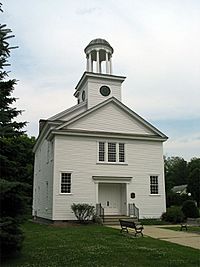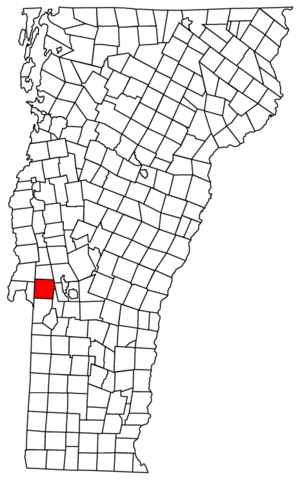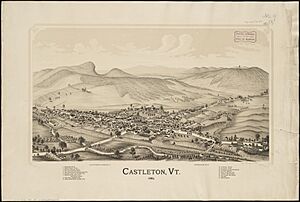Castleton, Vermont facts for kids
Quick facts for kids
Castleton, Vermont
|
|
|---|---|

The "Old Chapel" (Castleton Medical College Building) in Castleton
|
|

Castleton, Vermont
|
|
| Country | |
| State | |
| County | Rutland |
| Settled | 1770 |
| Chartered | 1761 |
| Communities |
|
| Area | |
| • Total | 42.4 sq mi (109.7 km2) |
| • Land | 39.0 sq mi (101.1 km2) |
| • Water | 3.3 sq mi (8.6 km2) |
| Elevation | 650 ft (198 m) |
| Population | |
| • Total | 4,458 |
| • Density | 105.14/sq mi (40.638/km2) |
| Time zone | UTC−5 (Eastern (EST)) |
| • Summer (DST) | UTC−4 (EDT) |
| ZIP Codes | |
| Area code(s) | 802 |
| FIPS code | 50-11950 |
| GNIS feature ID | 1462065 |
Castleton is a town in Rutland County, Vermont, in the United States. It is located about 15 miles (24 km) west of Rutland, which is the county's main city. Castleton is also about 7 miles (11 km) east of the border between New York and Vermont. In 2020, 4,458 people lived here. Castleton is also home to a campus of Vermont State University, which has been around since 1787.
Contents
History of Castleton
Castleton was first settled in 1770. Its official charter, or permission to be a town, was given in 1761. Governor Benning Wentworth of New Hampshire granted this charter for 36 square miles (93 km2) of land. The land was divided into 70 "shares." The governor kept two shares for himself, and others were set aside for churches and a school.
By 1770, three families had made Castleton their home. Some of the very first settlers, Amos Bird and Noah Lee, arrived in 1767 from Salisbury, Connecticut. A famous landmark, Birdseye Mountain, is named after Colonel Amos Bird. He owned 40 shares of land and built his home there in 1769. More settlers came, and by 1777, there were 17 families in the town.
Castleton's Role in the Revolutionary War
In May 1775, Ethan Allen and his group, the Green Mountain Boys, met in Castleton. They met with Benedict Arnold to plan an attack on Fort Ticonderoga. This fort was about 30 miles (48 km) west, across Lake Champlain in New York. They successfully captured the fort. This victory helped the American side for two years.
Later, in 1777, the British launched a strong attack south on Lake Champlain. Battles happened nearby in Hubbardton, and then at Bennington and Saratoga. These battles were a major turning point in the Revolutionary War in the North. Although German soldiers were in Castleton for a short time in 1777, they left as the war changed. People who supported the British, called Tories, were not welcome in Castleton. Fort Warren, built in 1777, was also located in Castleton.
Growth and Development After the War
After the war, Castleton continued to grow as a farming community. Farmers raised cattle and, for a time, sheep. The first businesses were sawmills and gristmills, which processed wood and grain. In the 1800s, the slate and marble industries became very important in and around Castleton.
The railroad arrived in 1854. This led to more tourism around Lake Bomoseen in the second half of the century. Many residents built fancy houses to replace their older, simpler homes. Several luxury hotels were built near the west end of the lake. A trolley system connected the town center to Lake Bomoseen, making it easy for summer tourists to visit. The Hydeville area also grew in the mid-1800s because of slate quarrying and milling.
Between 1900 and 1940, several fires damaged parts of Castleton. Despite this, the town still has many old buildings. These buildings show two hundred years of Vermont's history. Castleton's Main Street is famous for its tree-lined path and beautiful Federal and Greek Revival style houses. Many of these were built by Thomas Royal Dake. Almost all of Main Street is listed on the National Register of Historic Places.
Arts and Culture in Castleton
Museums and Interesting Places
- The Higley House: This house was built in 1810 by Erastus Higley. It is now a museum with old furniture and antiques. You can also see antique carriages on the property. The Castleton Historical Society takes care of the house. The Higley family lived there until 1973.
- The Castleton Federated Church: Master builder Thomas Dake built this church in 1833. It is listed in the Historic American Buildings Survey.
- The Cobbler's Shop: This old brick building is on the corner of Main Street and Cemetery Road. It was built between 1774 and 1794 by Nehemiah Hoyt. Some people believe it is the oldest brick building in Vermont.
- The Castleton Medical Chapel: This chapel was built in 1821. It was part of Castleton University (which was called Castleton State College at the time). It is located on Seminary Street, near the Fine Arts Center.
Education in Castleton
Castleton is part of the Slate Valley Modified Unified School District. The town has one school, Castleton Elementary School, for students in kindergarten through sixth grade. Older students from Castleton go to high school at Fair Haven Union High School and junior high at Fair Haven Union Middle School.
Castleton University is a public college located in Castleton. It offers many different subjects and has been around since 1787.
Transportation in Castleton
In 2009, Castleton started having an Amtrak train station. The station is located behind Main Street, close to the post office. The old train stop was updated that year to include an enclosed building. The train stop is only for the Ethan Allen Express train line.
Geography of Castleton
Castleton covers a total area of about 42.35 square miles (109.7 km2). Of this, about 38.9 square miles (101 km2) is land, and 3.45 square miles (8.9 km2) is water.
Within the town, there are three main areas:
- Castleton village: This is where you'll find the post office, town offices, a bank, a general store, and a 1940s-style diner. The university is also nearby.
- Lake Bomoseen: This is a 5-mile (8 km) long lake in the northwest part of town. It's a popular spot for resorts and fishing. The Bomoseen post office is in Castleton Corners, which is west of Castleton village and southeast of the lake.
- Hydeville: This area is an extension of Main Street at the south end of Lake Bomoseen. It also has a post office.
Neighboring Towns
Castleton is surrounded by several other towns:
 |
Benson | Hubbardton | Pittsford |  |
| Fair Haven | West Rutland | |||
| Fair Haven | Poultney | Ira |
Population of Castleton
| Historical population | |||
|---|---|---|---|
| Census | Pop. | %± | |
| 1790 | 800 | — | |
| 1800 | 1,039 | 29.9% | |
| 1810 | 1,420 | 36.7% | |
| 1820 | 1,541 | 8.5% | |
| 1830 | 1,783 | 15.7% | |
| 1840 | 1,769 | −0.8% | |
| 1850 | 3,016 | 70.5% | |
| 1860 | 2,852 | −5.4% | |
| 1870 | 3,243 | 13.7% | |
| 1880 | 2,605 | −19.7% | |
| 1890 | 2,396 | −8.0% | |
| 1900 | 2,089 | −12.8% | |
| 1910 | 1,885 | −9.8% | |
| 1920 | 1,919 | 1.8% | |
| 1930 | 1,794 | −6.5% | |
| 1940 | 1,601 | −10.8% | |
| 1950 | 1,748 | 9.2% | |
| 1960 | 1,902 | 8.8% | |
| 1970 | 2,837 | 49.2% | |
| 1980 | 3,637 | 28.2% | |
| 1990 | 4,278 | 17.6% | |
| 2000 | 4,367 | 2.1% | |
| 2010 | 4,717 | 8.0% | |
| 2020 | 4,458 | −5.5% | |
| U.S. Decennial Census | |||
According to the census in 2000, there were 4,367 people living in Castleton. Most of the people were White (97.98%). A small percentage were African American, Native American, Asian, or from other backgrounds. About 1.08% of the population was Hispanic or Latino.
Notable People from Castleton
- J. M. Adams: A politician who served in the Wisconsin State Assembly.
- Alexander W. Buel: A United States Representative from Michigan.
- Jeanne C. Smith Carr (1825–1903): An educator and author.
- Charles W. Davis: A Wisconsin State Senator.
- Edwin Drake: An oil driller known for starting the US oil industry.
- Patrick Villiers Farrow: An artist and brother of actress Mia Farrow. He lived in a historic church.
- Chauncey Langdon: A United States Representative from Vermont.
- Doc Maynard: One of the founders of Seattle.
- Amos Pollard: A surgeon who defended the Alamo.
- Ron Powers: A writer who won a Pulitzer Prize.
- Jarrod Sammis: A state representative for Vermont.
- Samuel Shaw: A United States Representative from Vermont.
See also
 In Spanish: Castleton (Vermont) para niños
In Spanish: Castleton (Vermont) para niños



